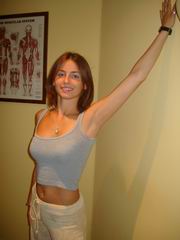Why do I need to Stretch?
In today’s world the nature of our lifestyle is much less active. We have, over the last few years become much more sedentary.
This is mainly due to the advances in technology. Sitting becomes the most commonly performed action. We no longer need to stand up and take down files or even go to the fax and copy machines. We do it all on our PC and more than ever our smart phones.
When we sit with our knees bent, the three hamstring muscles relax, they attach on our ‘sit bones’ (ischial tuberosities) and partly the back of the Femur. At the other end they attach below the inside and outside of the knee. They are, in essence a postural muscle responsible for controlling the strong quadriceps on the front of our legs. They need to remain in a state of constant readiness, called resting tone. If shortened for any length of time, small receptors in the muscles called ‘muscle spindles’ measure their length, send messages via the spinal cord to the cerebellum to reduce the resting tone length.
This is why after being seated for any length of time at a desk or in a car, plane, train or sofa, the act of standing become difficult as the muscles have become shortened. Stretching helps to re-set the resting tone to be longer again and also improve speeds and stride length when training.
Does Stretching Help?
Many patients ask about the benefits of stretching and whether or not it may help with their back problems. We will attempt here to explain the various benefits and disadvantages to be aware of within yourself, that may make Stretching part of your daily activities.
Recommended Daily stretches
Hamstrings, Hip Flexors, Gluteals, Calves, Neck muscles. For more details visit the following five pages on differing body areas for stretching.
Other muscles commonly shortened
In the side of the neck when holding the telephone for long calls regularly, ladies check out the raised muscles when trying on that nice summer dress that always slips of the shoulder. The back of the neck when slouching on your chair gazing at the lap top or screen that is too far away from you. A classic for developing that headache that comes on later in the day! Those Psoas or Hip flexors that attach fom the inside of your upper leg, head through the and under your tummy vessels to a fix to the front of the lumbar veterbrae, when you stand up they are tight and create a bigger dip in your low back, this can make your tummy look larger and bloated. Wearing High Heals shortens the calf muscles making wearing flat sandal painful in the achilles tendon.
Is it wise to see an Osteopath before starting regular stretches?
Probably a good thing as the osteopath will be able to assess the quality of the muscles and their respective functions. This allows the osteopath to advise which stretches are more beneficial and specific to you and the envirnment you are in.
The Osteopath
When visiting an Osteopath with chronic or acute problems, you are assessed and treated with a view to prevention of further injury, combined with corrective exercise. The Osteopath is empathetic to the patient’s need to establish a speedy recovery of the body and return to the achievement of intended goals.
At the clinic we offer Treatment sessions plus Sports massage and Stretching sessions
For appointments or advice please email appointments@theosteopath.net
